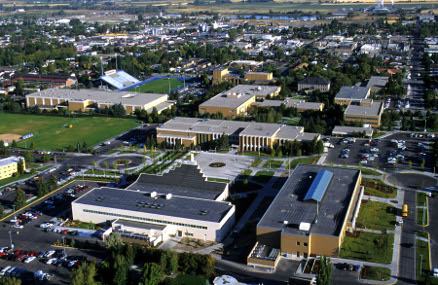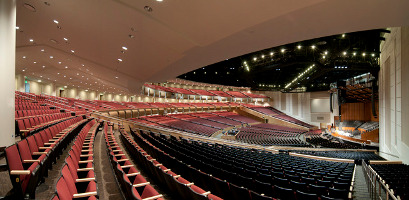Brigham Young University-Idaho
Currently, the most well-known school sponsored by The Church of Jesus Christ of Latter-day Saints is Brigham Young University, also known as BYU. Another, less-well known, school sponsored by the Church, is Brigham Young University-Idaho. Located 275 miles north of BYU, this university was previously known as Ricks College, a two-year junior college set in small-town Rexburg, Idaho.
The Church of Jesus Christ has always encouraged education. This is apparent in the sponsorship the Church has maintained through its current schools, as well as past academies.
Other examples of church-sponsored education include BYU-Hawaii, the Jerusalem Center for Near Eastern Studies, a global Church Educational System program, and the many church-sponsored youth programs, seminary, curriculum development, and conferences.
* Also see BYU-Idaho
Contents
From Junior College to Four-Year University
Previously the largest private junior college in the nation, It was announced in 2000 that Ricks College would become a four-year university known as Brigham Young University–Idaho. Then-Church President Gordon B. Hinckley explained that the name change was in order to help give the institution immediate national and international recognition.
Because of the acclaim that BYU has received over the years, it was a logical step for Ricks College to also be connected to the publicity of its sister school. In fact, the transition itself provided a great deal of public interest both from Church members and nationwide media.
In the nearly six years since BYU-Idaho began making the transition from being a two-year college to a full-fledged four-year university, there have been many interesting statements made by prominent leaders of the Church of Jesus Christ regarding the reason for the change, as well as the potential of the university and its students. For example, President Henry B. Eyring, member of the First Presidency (and a former president of Ricks College), stated that
- [BYU-Idaho] will become a place that people know of because of the insights that will come as we come to understand the teaching and learning process
- BYU-Idaho Devotional address, September 18, 2001, “A Steady, Upward Course,” p. 9.
One unusual aspect of BYU-Idaho’s campus culture is that faculty members are not required or expected to focus their efforts on research and publication, but rather, to spend the bulk of their energy developing better ways to teach. Although the school changed to a university, that focus on how to effectively teach students did not diminish.
The main changes to the college included: renovation of buildings, an increase in student population, students’ ability to stay longer than two years, the loss of the sports program and the gain of a new, innovative activities program, the development of several baccalaureate programs, and the expansion of the faculty.
The loss of the intercollegiate athletic program was possibly the hardest change for many members of the community, particularly former coaches and players. That BYU-Idaho was too remote and its budget too small were stated as reasons for the change.
Throughout the transition, many of the students, faculty, and community members who had been involved with Ricks College for several years held concerns that the school would lose its core flavor through so many changes.
In a letter written to students in the academic catalog, then-president David A. Bednar assured that,
- This continues to be a season of transition at this institution. … The programs and courses outlined in this catalog reflect the implementation of the programs being offered at the “new” institution. …
- Ricks College had long been recognized as a school where students received personal, individualized attention; where ecclesiastical leaders created spiritual havens for ward members; where students genuinely cared about other students. Many things have already changed at this institution; and, undoubtedly, many more changes will take place in the future. However, the unique environment found on this campus, which is often referred to as the Spirit of Ricks, need not change.
The biggest benefit which came from the transition of Ricks College to BYU-Idaho, is the opportunity for more Latter-day Saint students to attend the school for a longer period of time, with a more defined focus on long-term educational programs. The growth of the institution consumed high costs of faculty time, new construction, renovation, and financial support, all sponsored by the Church, which truly demonstrates the position of the Church of Jesus Christ to support the general education of its members.
In December, 2010, the BYU-Idaho Center and the Manwaring Center were dedicated. These two, newly completed buildings are the capstone projects of the foundation of BYU-Idaho. In a very real and dramatic sense, they mark the completion of the creation of the university [from Rick’s College].[1] The new BYU-Idaho Center looks almost identical to the Conference Center in Salt Lake City but seats 15,000 instead of 21,000. Four General Authorities of the Church spoke at the dedication of the buildings. All four of the speakers—President Clark, Elder David A. Bednar (a former president of BYU-Idaho), Elder Russell M. Nelson and President Henry B. Eyring (a former president of Ricks College)—expressed their profound gratitude for the devotion, sacrifices, faith and miracles that have been seen in the construction of these buildings and the expansion of this university.
Quick Facts
History
- 1888: The Bannock Stake Academy opens in Rexburg, Idaho
- 1898: The school is renamed Fremont Stake Academy
- 1903: The school is renamed Ricks Academy in honor of Thomas E. Ricks, founder of Rexburg and chairman of the school’s first Board of Education
- 1923: The school is renamed Ricks College
- June 2000: Ricks College becomes Brigham Young University–Idaho
School
- Currently, about 12,000 students attend BYU-Idaho, coming from all 50 states and 60 countries
- Half of the student body have served as Missionaries
- One-fourth of the student body are married
- Like their counterparts at BYU in Provo, students agree to live by an Honor Code
- Students can earn either associates or bachelors degrees divided among the six colleges
Campus
- There are currently about 40 major buildings on the 400 acre campus
- BYU-Idaho is located in Rexburg, Idaho and is within driving distance of Yellowstone National Park, Grand Teton National Park, and Jackson Hole, Wyoming
- The city is also the home of the Rexburg Idaho Temple
BYU-Idaho's Pathway Program
BYU–Idaho’s Pathway Program serves more than 50,000 students in 42 US states, and nearly 40 countries worldwide. What began as three pilot classrooms around the US in 2009 has become 387 sites around the world, with students of all ages and backgrounds getting started on a “path” that leads to education. There are launch programs in Asia, Africa, Latin America, and Europe. In Mexico alone there are over 70 Pathway sites. The program was designed for traditional college-age students who for whatever reasons either never enrolled in college or stopped attending, however, students of all ages, with half of the Pathway student body being 31 or older, are enrolling in the Pathway Program.
Students take three required courses (all done online) and meet in a group setting once a week on Thursday night wherever Institute is held in their area. The three required courses are life skills, math and personal finance, and basic writing. These courses combined with religion courses comprise a year of studies. Upon completion of the required courses, and having met the specific requirements for the courses, students are then eligible to transfer to another institution to finish their degree. Andy Cargal who was with the Pathway program since it began in 2009 stated, "Students are doing a lot of it on their own. But the gathering aspect once a week is important. … As students meet together, more learning can happen with both the spiritual and educational benefits.”
As of late October 2015, more than 13,000 students had received a Pathway certificate, and 8,673 students were enrolled in the BYU–Idaho online degree program. Clark G. Gilbert, Brigham Young University–Idaho President stated, “Pathway not only helps teach students how to learn and prepare to provide for their families, but it also helps deepen discipleship.”
For more information about the Pathway program, visit www.byupathway.org


